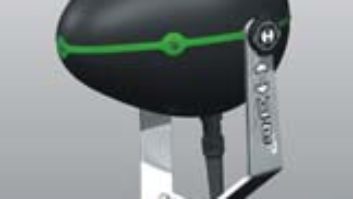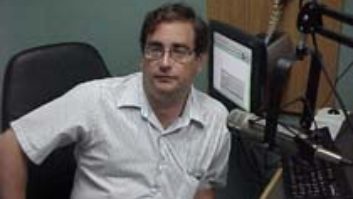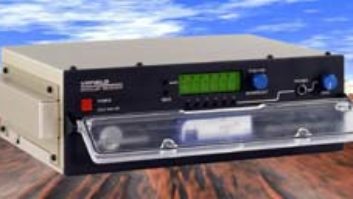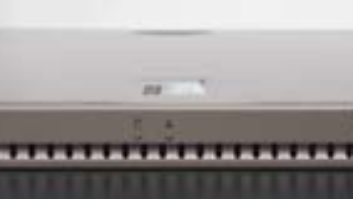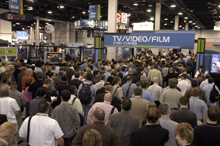
HD DEVELOPMENTS PUSH INTEGRATION, WORKFLOW
After days of squeezing through the record-setting crowd of 105,046 at this year’s National Association of Brodcaster’s show, the term on most people’s minds was probably “compression.” However, the real watchword of this NAB was “integration,” with manufacturers looking for ways to improve workflow and users looking for means to move more channels of audio around faster, with greater efficiency. HD production is here to stay, and digital television is a reality, so there was a sense that the time to get serious about sound has arrived, which is great news for the entire audio community. We scoured NAB’s gargantuan exhibit halls looking for audio excitement and there was plenty to be had. Here are a few highlights.
CONSOLES
In earlier years, big boards at NAB snagged most of the headlines, but the push this year was bigger feature sets and increased power from smaller console packages.

Calrec’s Bluefin technology lets existing Alpha owners upgrade from 226 to 480 (mono equivalent) channels simply by installing a couple DSP cards. Bluefin also puts full EQ and dynamics on all channels, and can provide 78 full 5.1 surround sound channels, eight 5.1 groups with full EQ and dynamics, four main outputs, 48 multitrack outputs and 20 aux outputs. According to company head John Gluck, Calrec wanted to boost performance for new users without leaving valued customers out in the cold. Look for more DSP offloads in the future. Already, NEP out of Pittsburgh has ordered two new Alphas. Who wants to buy a new console every time more power and speed is needed?

Fairlight announced six U.S. sales of its DREAM Constellation mixers and introduced a comprehensive HD production/encoding suite for audio finishing for HDTV and film. The company’s HD DREAM Factory comprises a dual-bay Constellation-XT large-format mixing console and Fairlight’s Pyxis HD nonlinear video system—an integrated platform for recording, editing and mixing to picture. The Constellation-XT multiformat mixing system is expandable up to 240 channels into 72 buses, with scalable DSP, integrated disk recording/editing, clip-based automation and more than 80 third-party plug-ins. Introductory pricing is $99,950.
Under new ownership for less than a year, SSL has made a huge turnaround, with many new products, including the AWS 900+, the second generation of its popular AWS 900 Analogue Workstation System. First shown at Musikmesse 2006, the “plus” version offers new control protocols for a wide range of digital audio workstations including Nuendo, SONAR, Digital Performer and Logic. With the new functionality, plug-ins and virtual instruments can now be controlled from the D-Pots and the faders, a hotly requested feature from many workstation users.

SSL’s big splash in post-production consoles, the C300, draws on the innovations of the C100 and C200 line, but in a post configuration, for one- or two-operator versions, with channel count expandable from 128 to 512 and up. Also standard is HUI support of workstation control functions. Nashville’s Fred Paragano—who’s carved a small post niche at his Paragon Studios—purchased the first C300 in the U.S. He’s putting it in Studio B to mix the children’s program Vegi-Tales.
Meanwhile, SSL expands the capability of its C100 digital broadcast board, with MORSE (Modular Resource Sharing Engine). The system is comprised of modular I/O, stageboxes and router hardware, allowing extremely dense concentration of audio I/O and router matrices for simple to large-scale applications. It’s easily expandable and optional PC control software can control asset ownership for smooth workflow. SSL also announced a new IFB Master Channel for the C100, for fast, direct access to multiple comm buses for intuitive handling of complex IFB requirements.

At Harman-land, we got a demo of Studer’s latest console, the Vista 5, and it is really quite impressive. Three banks of 10 faders that have four layers that can access up to 1,700 channels! The one-knob-per-job surface and integration of the rotaries into the TFT screen make it very intuitive and easy on the eyes. Add to that the very slick Vistonics user interface popularized by big brother Vista 8, and you’ve got a desk with some serious bling.
Designed for broadcast production, live sound and performance venues, Vista 5 is ideal for local television news production and for smaller remote vehicles where space and budgets are limited. The 32-fader desk has 20 channel strips optimized as input channels and 12 additional strips for operating output and input channels. Using the standard Vistonics screen, up to 52 outputs are under immediate control, with up to 240 channels accessible from the desk and laid out in any order. DSP power and I/O are specified by the customer. The total I/O capacity—comprising various cards, including mic/line, ADAT, TDIF, AES/EBU, SDI and MADI—may exceed 1,700 inputs and outputs.
And Vista 8 (reviewed in the April Mix,, was also drawing attention. In fact, Vista 8 installs include Fox Sports in L.A., where it will handle Sunday afternoon football, and AMV’s new HD truck out of New York… the company’s second Vista 8 in a truck.
Debuted at Frankfurt Musikmesse the month before, Soundcraft was busy demoing its Vi6 large-format digital and drawing crowds for its unique implementation of the Vistonics interface. The Vi6 offers fast, intuitive operation using touch-screen color TFT monitors with rotary control/switches mounted on the glass that’s based on Studer’s Vista consoles. Standard are 64 input channels in two layers of 32 motorized faders assignable to 32 outputs, which can be groups, auxes or matrix outs, plus stereo and mono mixes. FaderGlow multi-color LED illumination—orange for aux sends, green for groups, etc.—marks fader assignments for status at a glance. I/Os are in a remote box that connects via MADI over Cat-5 to the board… or a second Vi6 for monitors. For more on the Vi6, click here.
Euphonix showed some very cool new features of its System 5 Console. For one thing, Apple’s Logic Pro is now part of the EuCon protocol, meaning Logic Pro 7 can be controlled along with Pro Tools and other third-party DAWs, DSP hardware and plug-ins. Other big news? Euphonix’ MC Controller is now available as an “insert” for existing System 5 boards. Essentially, it’s EuCon Hybrid, which allows DAW integration (Pyramix, Nuendo, Pro Tools, Logic Pro…) to existing System 5 users through a pop-in MC controller. This means a user can map the surface with any configuration of controls; Pro Tools can be next to Logic can be next to Nuendo, etc., etc. Nice indeed! And Henninger Video is installing combo System 5-MC/Nuendo packages into its Arlington, Va. facility.
It’s taken a while for industry to get used to thinking of Digidesign in terms of being a large-format console manufacturer, but placing more than 1,000 ICONs in the past two years, makes a serious statement. Digi previewed Pro Tools 7.2, which adds significant power to its mix platform, including new automation features such as VCA-style grouping, pan groups, plug-in parameter linking, support of third-party paddle controllers, SignalTools comprehensive level and phase metering (up to 7.1 surround) and more.
Digidesign also showed a JL Cooper-designed Surround Panner Option for its ICON D-Command and Pro Tools HD systems, providing a touch-sensitive joystick with brushed-aluminum handle—plus knobs and mode buttons for individual parameter control and an integrated MIDI/power cable to reduce clutter. Expected to ship in Q3 2006, the Surround Panner Option will retail for $1,695.

Not all console news involved big money designs.The new IF-SM/DM card for Tascam’s DM-3200 console, essentially brings the power of its DSM-7.1 surround monitor controller to this affordable digital console. And Tascam’s US-122, US-224, US-428, FW-1884, FW-1082 and FW-1804 USB and FireWire audio interfaces are now compatible with Intel-based Macs, thanks to new Universal Binary drivers available as free downloads at www.tascam.com. Among the Intel-compatible drivers is one for the FW-1082, now with new documentation for integrating with Apple’s Final Cut Studio. The combination audio interface and audio/video control surface can function as a fader and edit controller for Final Cut Pro, as well as a MIDI control surface in Motion for real-time effect control and color correction. The control surface is also compatible with DAWs such as Logic Pro, Soundtrack Pro, Digital Performer, Cubase, Nuendo, SONAR and Pro Tools.
Audio Developments’ (dist. by Independent Audio,) newest portable mixer, the AD255, combines full functionality and an ergonomically-friendly design—all in a small-footprint, rugged aluminum case. Features include 6- or 8-channels, two auxiliary sends, channel direct outs, DC power and digital meter VU/PPM-selectable.
PRODUCTION ESSENTIALS

NAB just wouldn’t be an NAB without some interesting new mics, and this show didn’t disappoint. Beyerdynamic came on strong with the MC 840, an impressive new large diaphragm mic. This compact design features a gold-vaporized double-diaphragm capsule five polar patterns (omnidirectional, wide cardioid, cardioid, hypercardioid and figure eight), -10/-20 dB pad, two-stage roll-off filter for (80 and 160 Hz) and low-noise electronics. Retail is $1,695.
Making its first U.S. appearance was Neumann’s long-awaited TLM 49 large-diaphragm, cardioid, studio mic. With its roots firmly planted among the classic Neumann M 49 and M 50 microphones of the ’50s, the TLM 49 features the famous K47 capsule used in the M 49 and U47 microphones. The capsule has a linear frequency response up to the upper mid-range. Above 2kHz there is a gentle presence boost up to 3dB. And the TLM 49 operates at SPLs of up to 114dB without distortion. MSRP is $1,699.99.
Podcasters and project studios alike should welcome Audio-Technica’s new street pricings on its AT2020 and AT3060, now $99 and $399, respectively. The AT202 is a side-address, medium diaphragm cardioid condenser; the AT3060 is A-T’s popular phantom-powered, large-diaphragm tube mic. A-T’s Steve Savanyu was podcasting with the 3060 throughout NAB; check these out at www.audio-technica.com.
DPA introduced an ingenious little rubber pad that turns its great sounding, compact 4061 mini capsule mic into a boundary mic. Invented for boardroom, stage and low-profile aplications, the little pad should also be perfect for tucking into a kick drum.

New mics from Holophone make recording in surround more affordable than ever. The 5.1 H3-D 5.1 mic looks much like its higher-end H2-Pro, but uses proprietary capsules (instead of DPA) and goes for $1,695. Holophone also debuted its H4 SuperMINI, a camera mount unit about the size of a tennis ball that comes with a real-time encoder enabling the user to record an encoded feed directly to any 2-channel device.
Redding Audio displayed its latest mics and accessories from Voice Technologies of Switzerland. VT features a line of mini mics including the VT400 subminiature lavalier that’s nearly pinhead size. The company also makes in-ear headmount playback systems for broadcast and field use.
Broadcasters loved Rycote’s new Smoothie windscreen, which offers the same funcionality as the Rycote Softie, but adds the ability to print network/channel logo on the side.
Shure hawked the benefits of its UHF-R wireless, which has been shipping with bodypack and handheld KSM9 transmitters, but showgoers were equally interested in the newly-available wired KSM9 condenser mic, which features dual, gold-layered Mylar diaphragms, switchable polar patterns (cardioid/supercardioid), Class-A electronics and a choice of champagne or charcoal gray finishes.
Sennheiser’s SK 5212 is the smallest wireless microphone bodypack in its class. This frequency-agile design features a 36MHz tuning window for accessing up to 7,200 frequencies in 5kHz steps across the entire UHF spectrum (450 to 960 MHz). A single AA battery powers the SK 5212 reliably for six hours at its full 50mW output power. An easy-to-use jog dial and backlit LCD shows AF, RF, battery level and frequency information.
Said to be the world’s smallest pro audio wireless transmitters, Lectrosonics’ SM Super Mini line has new offerings. The SMD (SM-Dual) transmitter uses two AA batteries, doubling the battery life of the original SM unit. Also AA-powered, the SMQ (SM “Quarter Watt”) transmitter delivers 250mW power for longer range and greater resistance to interference than the standard 100mW SM. A clever RM (Remote Unit) communcates acoustic-modem-style with any SM-series transmitter via its microphone, sending commands such as operating frequency, audio level, sleep and control lockout, etc. to an SM unit that may be buried under a costume or clothing.

Zaxcom’s big emphasis on digital wireless has paid off again this year with the release of the TRX910 series transceiver (combo bodypack transmitter/IFB receiver) with time code. The TRX900AA runs on two AA batteries for up to 12 hours. Besides the TC feature, the TRX901 records .WAV format files simultaneously to a built-in SD memory card, so if the wireless gets stomped on, you still have audio. Meanwhile, the ZFR100 recorder will record broadcast-quality .WAV or MP3 directly to a 2-gig Flash card. It includes a full-featured time code reader/generator. The mono version is about $1k, stereo about $1.5k. Also, Zaxcom’s long-awaited Deva Mix-12 film-style production mixer—rather, a controller—should be available this summer. It has 3-band EQ and compression on each channel, along with a metadata input.
Sound Devices announced two additions to the 7 Series line of portable digital recorders: the 702 and 702T. These 2-channel recorders share the sound quality and field-tested chassis design of the successful 722 and 744T digital recorders. The 702 and 702T (with timecode) are Compact Flash-only recorders. The 702 and 702T recorders are available now and have a suggested retail price of $2,175 and $2,650, respectively.
PrismSound announced the Maselec MMA-4XR, a hot new 4-channel mic preamp. Designed by Leif Mases, the brains behind Maselec’s other high-end analog products, the unit promoses to be a no-compromise, ultra-transparent preamp that outputs exactly what you put into it. Nice!
DAWS, SOFTWARE AND BEYOND
Besides improved automation and ICON controller support, Digidesign’s Pro Tools 7.2 includes enhanced capabilities for editing video (working with multiple video clips, tracks and playlists), a new destructive record mode for punching into mix tracks without creating additional files, streamlined Avid-to-PT workflows, support for seven different field recorders. Slated for release in the second half of 2006, the $199 upgrade is bundled with a lite version of Virtual Katy 2 conforming software. In other news, Pro Tools LE 7.1.1 starts shipping next month with Intel-Mac compatibility.
The award-winning Virtual Katy audio post software integrates Pro Tools and Avid editing systems, greatly accelerating the post process. A quantum leap forward in processing speed, tracing and comparison engine techniques, the groundbreaking features of VK2 automate painstaking conform sessions for Pro Tools editors.
Previously available only on SADiE and Pyramix, CEDAR Tools 3.2 is a new suite of plug-ins from CEDAR for Pro Tools PC introduce the high-end capabilities of CEDAR Cambridge and CEDAR Retouch v3 to the Pro Tools world. The restoration modules for the Pro Tools|HD and LE (PC) platforms—Auto Declick, Manual Declick, Decrackle and Dethump—join Auto Dehiss, Delip and Retouch, all available as AudioSuite plug-ins.
A new member of the Pro Tools control family is Aphex. Its popular 1788A 8-channel mic preamp is now controllable from directly within Pro Tools, or using a hardwire remote or Mac/PC software. The 1788As recently saw action handling the live broadcast feed from the XM/Effanel truck at the Grammys.
SRS generated plenty of interest with new Circle Surround products. The Circle Surround TDM Pro 2.0 plug-in for Digidesign’s Pro Tools 7.0 (and above) includes CS encoding/decoding, along with Xtract up-mixing, which produces highly realistic 6.1-channel surround sound mixes from mono and stereo material with better image stability and natural sound than offered previously. Designed for field/location recording, the SRS CSE-06P Portable Circle Surround Encoder is a belt-pack encoder designed to prepare 5.1 or 6.0 multichannel audio stored to 2-channel recorders and ENG/EFP cameras. It includes the SRS Headphone PRO surround monitoring mode, for listening to discrete 5.1-channel mixes over conventional headphones, for realistic assessment of the captured surround material. Now, portable surround recordings can be delivered for playback, editing and broadcast in surround sound through existing two-channel SD and HD infrastructures.
SADiE’s booth was packed with showgoers checking out its V5.5 software release. V5.5 features a radical user-interface improvement , with a new coloring scheme to ease identification of individual streams and groups in the playlist and relate them to their mixer strips. Now the whole fader panel lights up in color—rather than just the channel ID at the bottom of the screen as in other DAWs. The interface makeover also introduces a new look to the toolbars and buttons in the playlist and mixer. The company also debuted its PCM-H16, a beefy and affordable DSP engine with I/O. Features includes 16 channels of AES and high quality A/D and D/A inputs and outputs, 64 streams of 24-bit/48kHz audio with real-time crossfades and punch-ins, and offers similar DSP processing power to the flagship PCM-H64 multi-track system.
VCube SE from Merging Technologies is a high definition-capable video recorder designed to work with all mainstream DAWs. Controlled through RS-422, MIDI Machine Control or Ethernet, the VCube SE is derived from Merging’s high-end VCube HD-2K system, capable of supporting video formats including OMF, MXF, MPEG, AAF, QT, AVI and more. The system comes as a card set and software, or as a turnkey solution installed in a high-spec Dell PC. The starting price for the system is less than $4,500 (SD version) and $6,000 (HD version).
Audio compression/codec specialists APT talked about a licensing deal with Source Elements (www.source-elements.com) that will allow the Source-Connect TDM Pro Tools plug-in to stream apt-X encoded files over the Internet. We’ll keep watching this one…

Sonicfire Pro 4, the latest version of SmartSound’s music creation software introduces a new capability called Mood Mapping. Supporting Windows and Mac systems, Sonicfire Pro 4 helps users create music soundtracks that are custom-fit to videos in just minutes. Each Sonicfire Pro 4 music selection has a Mood Map track, where users identify points in the production where mood changes occur. Changes in the score’s mix to fit each mood are selected from a wide range of preset mixes, each having individual instrument layers set to different levels, depending on the desired feel. The software includes thousands of royalty-free tracks as fully orchestrated cuts.
With all the talk—and action—about integrating multichannel audio into games, cable and satellite TV, HD broadcasts, DVDs, Blu-Ray and everything else we watch or hear (probably even cell phones someday), the Dolby booth was jammed with attendees looking for answers to their surround needs. Dolby was touting the benefits of its Dolby Digital Plus core technology, which maintains backward compatibility with millions of Dolby Digital-equipped S/V systems worldwide, while providing higher efficiencies for broadcasters and more channels for new packaged media formats. One key to this is the Dolby Media Producer, a suite of Mac OS-based HD and DVD creation tools, including Dolby Media Encoder, Dolby Media Decoder and Dolby Media Tools for handling codec and metadata chores in Dolby Digital, Dolby Digital Plus, MLP and Dolby True HD. Another solution is its DP600 Program Optimizer, offering intelligent audio analysis and automated loudness correction for most of today’s common broadcast media file/audio formats. Targeted for cable/satellite/IPTV/terrestrial TV broadcasters using a file-based infrastructure and workflow, the DP600 provides a consistent audio experience across all programming. Options include file-based (faster-than-real-time) audio encoding and decoding support for Dolby Digital (AC-3), Dolby Digital Plus (E, AC-3) and Dolby E. Dolby.
CERTIFIED HITS
Selecting our Top-10 list out of thousands of products from hundreds of exhibits was tough—there were many fine runner-ups—but we somehow managed to whittle down our selection to the following finalists. Listed alphabetically, here are our choices…
Calrec Bluefin
Digidesign Pro Tools 7.2
Fairlight HD DREAM Factory
Holophone H4 Mini
SADiE V5.5
Smartsound SonicFire Pro 4
SRS CSE-06P Portable Circle Surround Encoder
Studer Vista 5
Tascam DM-3200/IF-SM/DM
Zaxcom TRX901
MORE, MORE, MORE
Obviously, there was more at NAB, and we’ll be presenting more product highlights from the show in our regular new product columns as well as in the Daily News section of www.mixonline.com. Better still, slide over to http://mixonline.com/nab2006 for complete NAB 2006 coverage, with links to our show blogs, Vlogs, Tech Minutes, Newsletters, Podcasts and an extensive onl-line New Products Guide.
Meanwhile, NAB returns to everybody’s favorite desert paradise next year, from April 14-19, 2007, so now’s the time to lock in those advance bargain hotel reservations and put a reminder to get your taxes done before the show. Oh, and have a lucky day!

Sidebar
THE POWER BEHIND THE PODCAST
Sony was nice enough to lend us its stellar PCM-D1 handheld recorder for our Mix Podcasts from NAB 2006. (Note: Check out these podcasts at http://mixonline.com/nab2006). The unit feels and looks like quality right out of the box with its sizeable backlit screen and twin circular analog meters on the face. Ergonomics are the order of the day with the PCM-D1 offering gain control right where your thumb falls when you’re holding the unit and although it’s hefty, it never felts awkward. The twin condenser mics are in an X/Y array and swivel up and down to make sure you’re keeping your subject in the sweet spot.
Using the PCM-D1 at 44.1kHz/16-bit provided more than six hours of record time on the 4 GB of internal Flash memory, but it also records at up to 96kHz at 24 bits. Another standard feature is a slot for a Sony Memory Stick for those wishing a more portable storage option. At the end of each day, it was a breeze to port the unit into a Mac laptop via USB and simply drag the files into M-powered Pro Tools for editing. The great thing was taking it out of the case at each booth we visited. It was like having a Sports Illustrated swimsuit model on my arm as I watched jaws drop as everyone ooh’ed and awwwed. It is truly one cool machine: easy to operate, great-sounding and worthy of any admiration placed upon it. Thanks, Sony!! —Kevin Becka


